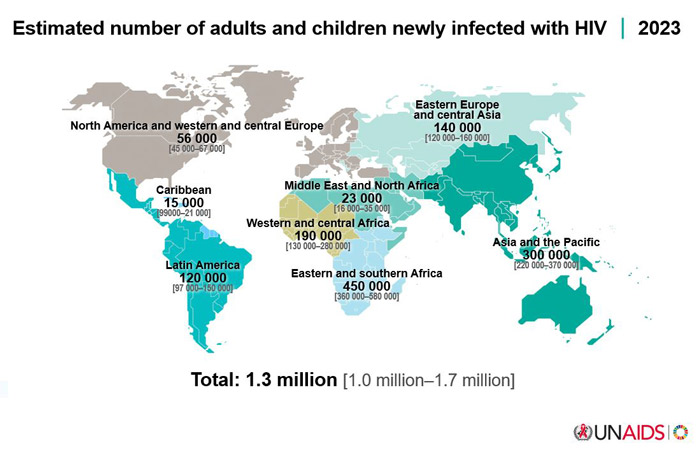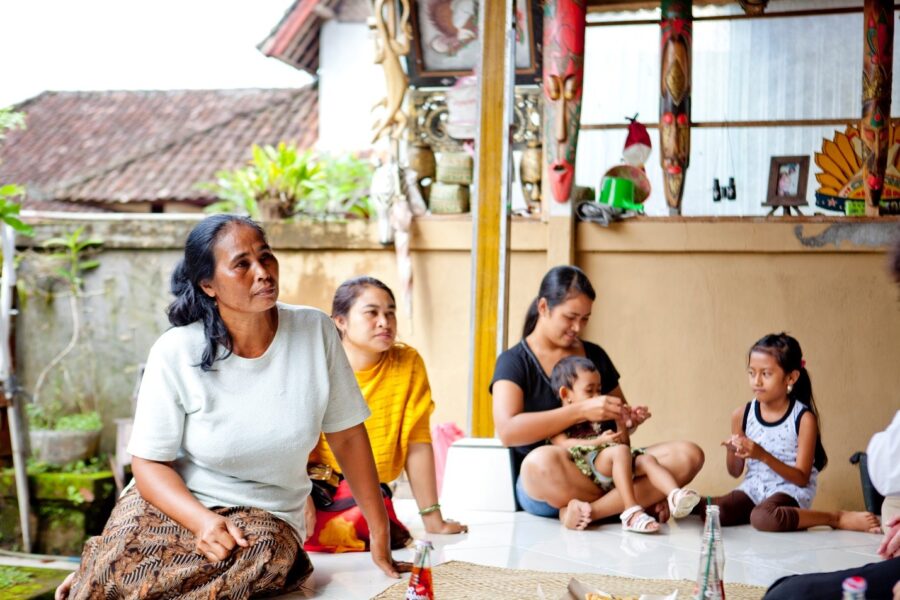HIV/AIDS in the World
- Approximately 39.9 million people worldwide are living with HIV.
- 53% of all people living with HIV (PLWH) are women and girls.
- While 86% of PLWH were aware of their status in 2023, approximately 5.5 million did not know they were living with the virus.
- The age group least likely to receive HIV treatment—children aged 0-14.
- An estimated one-quarter of all people living with HIV were 50 years and older in 2023.
- Annual deaths from AIDS-related causes were estimated to be 630,000 in 2023.

New infections
- New HIV infections totaled 1.3 million, a decline of 40% since 2010.
- Roughly 3,600 adults and children acquire HIV each day.
- In 2023, fewer people acquired HIV than at any point since the mid-1990s, and 39% fewer people acquired HIV compared with 2010.
- Members of key populations (men who have sex with men, people who inject drugs, sex workers, transgender women, and people who are incarcerated) and their sex partners accounted for an estimated 80% of new infections outside sub-Saharan Africa and 25% of new infections in sub-Saharan Africa in 2022.
- In 28 countries, new infections are on the rise, primarily in eastern Europe and central Asia, the Middle East and North Africa, and Latin America. New infections have decreased in Asia and the Pacific, western and central Europe and North America, the Caribbean, western and central Africa, and eastern and southern Africa.
- For the first time, new infections outside of sub-Saharan Africa were greater in number than new infections in sub-Saharan Africa.
AIDS-related deaths
- Annual deaths from AIDS-related causes were estimated to be 630,000 in 2023.
- Eastern and southern Africa is the region with the most AIDS-related deaths: 260,000; Asia and the Pacific have the next highest number: 150,000; North America and western and central Europe have the least: 13,000.

Access to treatment
- 30.7 million people (76.9% of all PLWH) were accessing antiretroviral therapy in 2023.
- Access to treatment expanded across all regions, leading to a 51% decrease in numbers of AIDS-related deaths globally since 2010.
- Along the continuum of care for all: 86% of PLWH knew their status in 2023; among them, 89% had accessed antiretroviral therapy; and 93% of PLWH on treatment had achieved viral suppression. By category:
- Women (aged 15+ years): 91%-91%-94%
- Men (aged 15+ years): 83%-86%-94%
- Children: 66%-86%-84%
Access to PrEP
- Oral PrEP use continued to increase: from a little over 200,000 in 2017 to about 3.5 million in 2023.
- It should be noted that expansion of PrEP services is limited to a small number of countries. Globally, only 15% of the estimated need for PrEP is being met.
HIV Among Key Populations
- Key population programs are underfunded across all regions. At least half of all people from key populations are not being reached with prevention services. More than half of all new HIV infections occurred among people from key populations and their sexual partners in 2022
- Risk of acquiring HIV (compared to the general adult population, 15-49):
- MSM: 23 times higher
- People who inject drugs: 14 times higher
- Sex workers: 9 times higher
- Transgender women: 20 times higher
- People who are incarcerated: 7.2 times higher
HIV Among Adolescent Girls and Young Women/Adult Women
- Gender-based violence impacts individuals beyond physical and traumatic effects—studies show that this type of violence increases HIV acquisition risk in countries with high HIV prevalence and decreases prevention uptake and use of services.
- In 2023, 44% of all new infections occurred among women and girls. In general, women more than men have seen stronger declines in numbers of new infections (though HIV incidence is still extremely high in parts of eastern and southern Africa and western and central Africa).
- Globally, 4,000 adolescent girls and young women aged 15–24 years acquired HIV every week, with 3,100 of these infections occurring in sub-Saharan Africa.
- In 2023, 84% of pregnant and breastfeeding women living with HIV had access to antiretroviral treatment to prevent transmission of HIV to their children.

HIV Among Children
- The age group least likely to receive HIV treatment—children aged 0-14.
- Approximately, 120,000 children (under 15) newly acquired HIV in 2023 globally, with the most impacted regions being eastern and southern Africa (32,000), western and central Africa (33,000), and Asia and the Pacific (6,100).
- Children aged 0–14 years account for the steepest declines in numbers of new HIV infections, largely as a result of progress in eastern and southern Africa (where the annual number of children acquiring HIV fell by an estimated 73% between 2010 and 2023).
- Eighteen countries or territories have eliminated vertical transmission (formerly called mother-to-child transmission).
- In 2023, an estimated 76,000 children died of AIDS-related causes—12% of all AIDS-related deaths, even though children are only 3% of all people living with HIV.
- In total, roughly 1.4 million children were living with HIV in 2023, with an estimated 590,000 of these children not receiving treatment.
- In 2023, 66% of children living with HIV knew their status; 86% of those who knew their status were on ART (57% of all children living with HIV were on ART); and 84% of those who knew status had achieved viral suppression (48% of all).
The Regional Picture (2023)
Eastern and southern Africa
- People living with HIV: 20.8 million
- New infections: 450,000
- AIDS-related deaths: 260,000
- People living with HIV on ART: 83%
- This region has seen a 59% decrease in new HIV infections, as well as a 57% decrease in AIDS-related deaths since 2010. Adolescent girls and young women aged 15–24 years accounted for 27% of new HIV infections.
Asia and the Pacific
- People living with HIV: 6.7 million
- New infections: 300,000
- AIDS-related deaths: 150,000 (a decline of 51% since 2010)
- People living with HIV on ART: 67%
- The majority of new HIV infections in this region are among people from key populations.
- Antiretroviral coverage for people living with HIV is uneven across the region; 80% in Cambodia, Nepal, New Zealand and Thailand received treatment but the proportion fell below 50% in eight of the 21 countries with available data: Afghanistan (9%), Bangladesh (49%), Fiji (28%), Indonesia (31%), the Islamic Republic of Iran (43%), Mongolia (39%), Pakistan (15%) and the Philippines (43%).
Western and Central Africa
- People living with HIV: 5.1 million
- New infections: 190,000
- AIDS-related deaths: 130,000
- People living with HIV on ART: 76%
- New HIV infections decreased by 46% between 2010 and 2023.
- Only 35% of children living with HIV are receiving antiretroviral therapy.
Latin America
- People living with HIV: 2.3 million
- New infections: 120,000
- AIDS-related deaths: 30,000
- People living with HIV on ART: 73%
- Since 2010, AIDS-related deaths have decreased by 28%. Annual new HIV infections have increased by 9%. Key populations have shown significant increases, according to 2022 data—numbers of new HIV infections were 20% higher than in 2010 among gay men and other men who have sex with men, 42% higher among sex workers, and 19% higher among transgender women.
The Caribbean
- People living with HIV: 340,000
- New infections: 15,000
- AIDS-related deaths: 5,100
- People living with HIV on ART: 70%
- In this region, new HIV acquisitions decreased by 22% since 2010. Increased treatment coverage led to a decrease in AIDS-related deaths of 57% between 2010 and 2022 (though Belize, Cuba, Guyana, and Suriname all had increases).
Middle East and North Africa
- People living with HIV: 210,000
- New infections: 23,000
- AIDS-related deaths: 6,200
- People living with HIV on ART: 49%
- People from key populations and their sex partners make up an estimated 84% of new HIV infections.
Eastern Europe and central Asia
- People living with HIV: 2.1 million
- New infections: 140,000
- AIDS-related deaths: 44,000
- People living with HIV on ART: 50%
- According to 2022 data, 94% of new HIV infections occurred among people from key populations and their sex partners.
Western and central Europe and North America
- People living with HIV: 2.3 million
- New infections: 56,000
- AIDS-related deaths: 13,000
- People living with HIV on ART: 77%
- This region has seen a 24% decrease in new HIV infections since 2010. Coverage of HIV testing and treatment services remained high in Western and Central Europe (though with Central Europe doing more poorly than Western Europe). According to 2022 data, approximately 91% of people living with HIV knew their HIV status, 93% of these received antiretroviral therapy, and 96% of people on treatment had a suppressed viral load.
Sources
UNAIDS Global AIDS Update 2024
UNAIDS Global HIV & AIDS Statistics Fact Sheet 2024